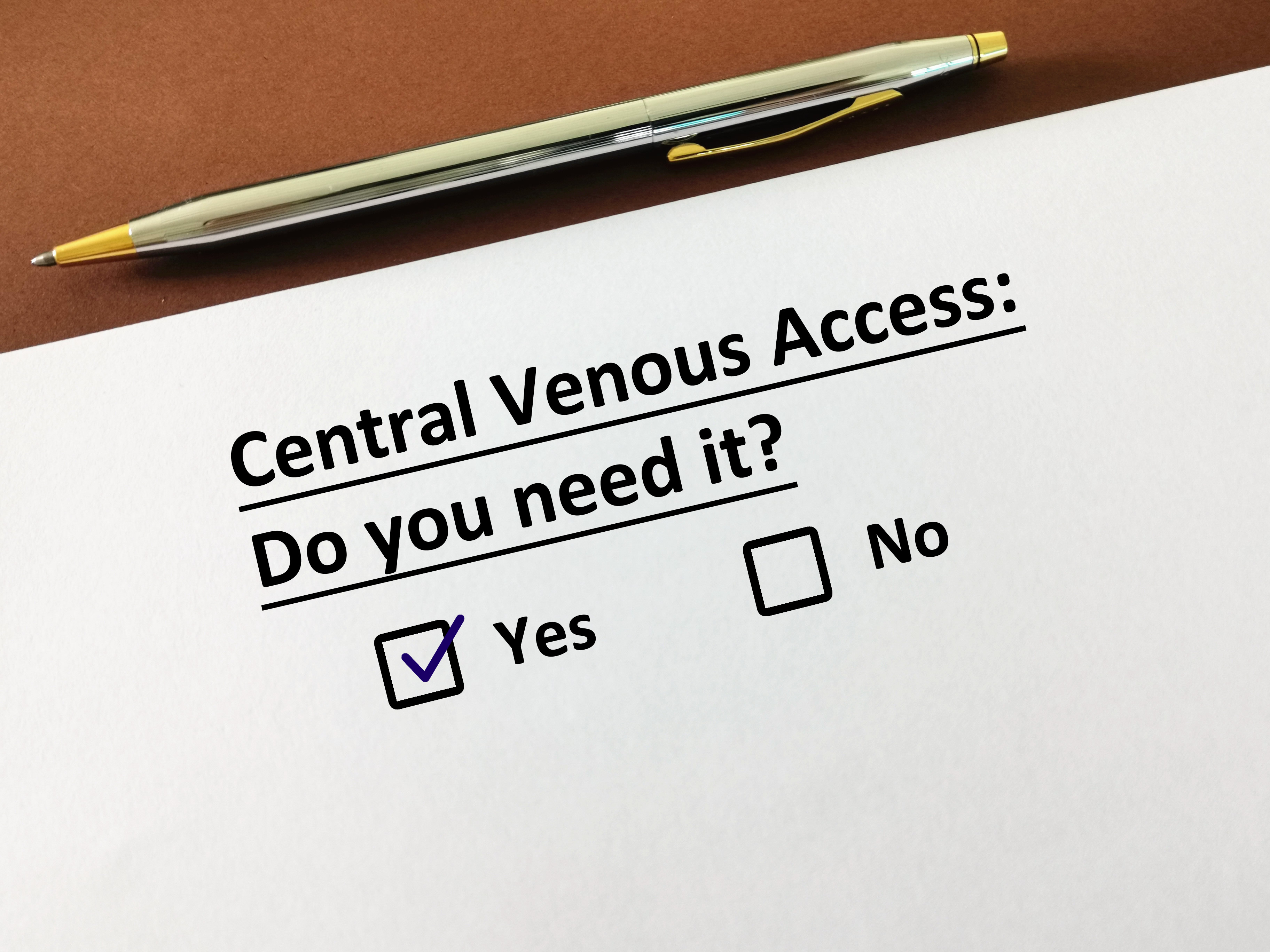The Percutaneous Central Venous Access Device (CVAD) Insertion Checklist – Adult is an initiative of the Queensland Health, Statewide Anaesthesia and Perioperative Care Clinical Network (SWAPNet) and was developed to support clinicians in central venous access device insertion and improve outcomes for patients.
Insertion of a CVAD is a common hospital procedure with over 14,000 devices inserted in Queensland Health facilities every year. Indications for CVADs include:
- Administration of infusion therapies and highly irritant and vesicant medications
- Reliable access for critically unwell
- Urgent access for life saving measures
- Multiple/ high frequency incompatible infusates
- Central venous pressure monitoring
- High flow rate infusions
- Haemodialysis / apheresis
- Frequent blood sampling
Despite being a common procedure it is not one without significant risks including risks associated with insertion of the devices and those associated with having a CVAD in situ either short or long term. These risks can include infection, malposition, extravasation, haemo/pneumothorax, thrombosis, vascular injury and air embolus. Although the complication profile for these devices is not fully defined, incident reporting has brought to light several instances where patient harm has resulted from technical aspects of CVADs insertion and/or maintenance. Although numerous guidelines exist for CVAD management, they tend to focus on prevention of catheter related infections with minimal attention to the technical aspects of insertion or device selection and characteristics. This checklist has been developed to complement existing guidelines.
Please note: The CVAD Insertion Checklist is available in interactive pdf and paper format. The interactive pdf version must be saved to your desktop / drive before being completed (eg. right click, save as PDF and open in Adobe Reader or similar). The content within the checklist changes in line with the selected procedure. The paper version of the CVAD Insertion Checklist can be downloaded and printed out as required.
If you experience difficulty using either checklist, please contact the SWAPNet Coordinator on 3328 9164 or SWAPNET@health.qld.gov.au.
- Australian Commission on Safety and Quality in Health Care, ACSQHC. (2017). National Safety and Quality Health Service Standards Second Edition. In (pp. 86). Sydney, NSW.
- Balsorano, P., Virgili, G., Villa, G., Pittiruti, M., Romagnoli, S., De Gaudio, A. R., & Pinelli, F. (2019). Peripherally inserted central catheter–related thrombosis rate in modern vascular access era—when insertion technique matters: A systematic review and meta-analysis. The Journal of Vascular Access. doi:10.1177/1129729819852203.
- Bodenham Chair, A., Babu, S., Bennett, J., Binks, R., Fee, P., Fox, B., Tighe, S. Q. (2016). Association of Anaesthetists of Great Britain and Ireland: Safe vascular access 2016. Anaesthesia, 71(5), 573-585. doi:10.1111/anae.13360.
- Frykholm, P., Pikwer, A., Hammarskjöld, F., Larsson, A. T., Lindgren, S., Lindwall, R., Akeson, J. (2014). Clinical guidelines on central venous catheterisation. Swedish Society of Anaesthesiology and Intensive Care Medicine. Acta Anaesthesiol Scand, 58(5), 508-524. doi:10.1111/aas.12295.
- Gorski, LA, Hadaway, L, Hagle, ME, Broadhurst, D, Clare, S, Kleidon, T, Meyer, BM, Nickel, B, Rowley, S, Sharpe, E & Alexander, M, 2021, ‘Infusion Therapy Standards of Practice, 8th Edition’, Periodical Infusion Therapy Standards of Practice, 8th Edition, vol 44, no.1S, pp.S1-S224.
- Hade, A. D., Beckmann, L. A., & Basappa, B. K. (2019). A checklist to improve the quality of central venous catheter tip positioning. 74(7), 896-903. doi:10.1111/anae.14679.
- Intensive Care NSW, Intensive Care Guidelines Statewide Guidelines, Central venous access device.
- Lathey, R. K., Jackson, R. E., Bodenham, A., Harper, D., Patle, V., Audit, t. A., & Yorkshire, R. M. o. (2017). A multicentre snapshot study of the incidence of serious procedural complications secondary to central venous catheterisation. 72(3), 328-334. doi:10.1111/anae.13774.
- Moureau, N. (2019). Vessel Health and Preservation: The Right Approach for Vascular Access.
- Moureau, N., Chopra, V. (2016). Indications for peripheral, midline and central catheters: Summary of the MAGIC recommendations. doi.org/10.12968/bjon.2016.25.8.S15.
- Rajasekhar, A, Streiff, M (2017). How I treat central venous access device-related upper extremity deep vein thrombosis, National Library of Medicine, 129(20):2727-2736. doi:10.1182/blood-2016-08693671.
- Sharp, G., Green, S., & Rose, M. (2016). Chlorhexidine-induced anaphylaxis in surgical patients: a review of the literature. 86(4), 237-243. doi:10.1111/ans.13269.
- Simonov, M., Pittiruti, M., Rickard, C., Chopra, V., (2015), Journal of Hospital Medicine, Navigating venous access: A guide for hospitalists. Doi.org/10.1002/jhm.2335.
- Tuffaha HW, Marsh N, Byrnes J, Gavin, N., Webster, J., Cooke, M., & Rickard, C. M. (2019) Cost of vascular access devices in public hospitals in Queensland. Aust Health Rev. 2019;43(5):511-515. doi:10.1071/AH18102.
- Schults JA, Kleidon T, Chopra C, et al. (2020) International recommendations for a vascular access minimum data set: A Delphi consensus-building study.
- A narrative review of long-term central venous access devices for the intensivist – link to: A narrative review of long-term central venous access devices for the intensivist (nih.gov)
- Anaesthesia UK, Central Venous Access – link to: Anaesthesia UK : Central venous access (frca.co.uk)
- ANZCA Guideline on infection control in anaesthesia (PS28) – link to: PS28-Guideline-on-infection-control-in-anaesthesia (anzca.edu.au)
- Central Venous Access Device (CVAD) Management - link to: 001899: Central Venous Access Device (CVAD) Management (health.qld.gov.au)
- CVAD Education - link to: PA Hospital | Division of Medicine | Vascular Access Surveillance Team - CVAD Education (health.qld.gov.au)
- ICNSW Central Venous Access Device Post Insertion Management - link to: Central venous access device | ICNSW)
- Intra-vascular device management – link to: Intra-vascular device management | Queensland Health
- NHMRC revised Australian Guidelines for the Prevention and Control of Infection in Healthcare – link to: Draft revised Australian Guidelines for the Prevention and Control of Infection in Healthcare submission | NHMRC Public Consultations
- Percutaneous Central Venous Catheters Guideline - link to: Guideline: Percutaneous central venous catheters (health.qld.gov.au)
- Practice Guidelines for Central Venous Access 2020 – link to: Practice Guidelines for Central Venous Access 2020 | Anesthesiology | American Society of Anesthesiologists (asahq.org)
- Preventing Retained Central Venous Catheter Guidewires – link to: Preventing Retained Central Venous Catheter Guidewires | Anesthesiology | American Society of Anesthesiologists (asahq.org)
- Venous air embolism related to the use of central catheters revisited – link to: Venous air embolism related to the use of central catheters revisited: with emphasis on dialysis catheters (nih.gov)
- Venous Thromboembolism Prevention Clinical Care Standard – link to: Venous Thromboembolism Prevention Clinical Care Standard | Australian Commission on Safety and Quality in Health Car


